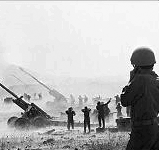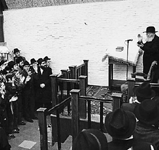Home
Letters
Article
Pictures
Soul Meetings
About
Contact

Creating a cure before the war
There cannot be many Jews throughout the world who were unaffected by the momentous events in the Middle East during the past few weeks, the sudden attack by the Arabs against Israel on Yom Kippur, and the apparent swing from the brink of defeat to an almost complete military victory for Israel.
Some Jews were directly involved in the fighting, many volunteered their
services, most contributed much needed money. But the sense of identification
was universal.
All the concern, prayers and action, however, only began after the war
started on Yom Kippur, but prior to this it seemed that no-one had an
inkling of what was to come, and certainly it was apparent that there
was no need for active preparation for a war, it seemed to the general
public to be a rather remote possibility.
Nevertheless, a more careful scrutiny of events reveals that there was,
in many parts of the world, a veritable hive of activity which unknown
to many of the participants was a direct preparation for the conflicts
and troubles that was to come.
The preparation began some four months prior to the war, in June 1973,
when the Lubavitcher Rebbe, Rabbi Menachem Schneerson, in New York, made
an unprecedented request to his followers the world over, and from the
way he made the request it was obvious that its importance and gravity
could not be over estimated. The Rebbe asked his followers to contact
children, and to ask them to do two things:
Firstly, to make a special effort to further their Jewish studies during the summer vacation, so that their holidays would not be devoid of Torah, and secondly to give some money of their own to charity. In order to encourage them in these matters, the Rebbe sent each and every child a letter explaining the importance of learning the Torah and giving charity accompanied by a sum of money, which was given for redistribution to a charity. In Britain every child received 10p and throughout the world children received similar amounts in their own currency. The following paragraph of the letter tells the secret of all this activity in a few succinct words:
"I want you to consider carefully the special merit which children have, a merit which affects our entire Jewish people, to which King David refers in the following words: "Out of the mouths of babes and infants you have ordained strength to still the enemy and the avenger" including also the enemy that has caused the "Three Weeks" (a time of mourning over the destruction of the temple) and still seeks vengeance to this day. In other words the way to vanquish and silence the enemy is through the study of Torah, called "strength" by the mouths of young children.''
The letter went on to show that through charity as well as Torah the redemption is brought closer. It ended with a request to join in the partnership of giving charity, together with a blessing for a successful school year of Torah study and the fulfillment of the Mitzvoth - commandments.
In each country, Lubavitch leaders were free to choose their own methods of getting children to learn Torah and in Britain it was decided to organize a STEP Campaign (Summer Torah Education Program) of which the highlight was a competition which ensured that every child who entered, would have to learn some Torah each day in August the campaign gathered momentum during the month of Tammuz, and on the beginning of the mornth Av, the Rebbe issued the following message, which very few individuals really understood:
"One should speak about these activities throughout the world, and how to 'conquer' the youth the world over, beginning in Israel. The young boys and girls are expecting it.
"The time is ripe like never before.
It is an urgent matter of life and death. I have emphasized all this many times, and lately it is stressed that all the above should begin with the youngest children, as it says “Out of the mouths of babes and infants etc.”
During Elul [September], it seemed that the summer activity, which had come to an end, was no longer crucial or urgent, but events proved otherwise.
The week before Rosh Hashana, the Rebbe announced that once again, children should be contacted, and asked to give a coin to charity. They were also asked to recite the Shema prayer and other Torah passages. The meaning of Rosh Hashana and the merit of a child's learning and mitzvoth were explained to them.
The 6th of Tishrei was the anniversary of the passing of the Rebbe's mother, Rebetzin Chana Schneerson OBM, and on this occasion the Rebbe issued an open letter on the purpose of Jewish people, and how their spiritual power outweighs their minority position in the world.
On the eve of Yom Kippur he added reference to the one of the commentary’s anecdote on Chana's prayer (I Samuel 2), who interprets the song of Chana as a prophecy referring to the victorious war which the Jewish people were to wage against other kingdoms.
In the early hours of the war, when the position of Israel appeared bleak, the Rebbe added that this refers to the present time, implying that Israel and the Jewish people would enjoy a great victory. He strongly requested that the letter with the highly important message should be published in Israel as soon as possible, "so that they would not worry about the war!"
From the moment that the news of the war was received throughout the world, the main preoccupation of Jews was the situation in Israel. Special prayers, Psalms, Torah learning and demonstrations were the order of the day, apart from the vast amount of money that was collected in a few days.
However, in a part of New York, a totally different atmosphere prevailed.
As early on as Rosh Hashanah it was apparent to those present that there was a marked change in the Rebbe’s usual conduct, and instead of seriousness on that day he showed a degree of joy that was remarked upon by all. The news of the war arrived on Yom Kippur morning (US time) and at the end of Ne'ilah (closing prayers on Yom Kippur) the Rebbe led joyous singing which far surpassed that of previous years.
On the night of the eve Sukkoth, at a gathering that was broadcast throughout the world, the Rebbe explained his conduct of intensified joy in spite of the suffering and anguish caused by the war.
He stressed that one of the ways of invoking Divine aid is by elevating oneself to a higher spiritual level and solving the problem as it were from above. This is epitomized by joy which breaks all barriers.
From this time onwards, and throughout Sukkoth, the Rebbe urged everyone, everywhere, to get together in gatherings, large and small, and to celebrate to break down the spiritual and physical barriers with the strength of our rejoicing.
All this reached a climax on Simchat Torah, when throughout the world Lubavitcher synagogues experienced higher levels of joy than ever before, whilst in New York the joy and dancing were almost unbounded, almost without respite. Other synagogues were encouraged to in-crease their expression of joy through dancing with the Torah in spite of the natural inclination to tone down Simchat Torah celebrations, in view of the grave situation in Israel.
Make no mistake about it, all this was very difficult to achieve, and far from being a lack of feeling for the sufferings of fellow Jews, it was in fact the highest expression of feeling on the part of the Lubavitcher Rebbe and by the same token of his followers throughout the world, depression helps no one, and we are told that joy breaks down barriers, and is a way of serving G-d, even in the most difficult times. It was left to the person who showed such concern for the plight of Israel well before the situation was an actuality (by making spiritual preparations for victory with the help of the small children) to lead the way during the war, and to adopt an attitude of calculated to help the situation.
Although considerations of space preclude it, there is much more to tell of the days between Yom Kippur and Simchat Torah, when visitors to Lubavitch in New York experienced levels of spiritual feeling, saw and felt the elation and elevation, of possibly the most eventful Tishrei for the Jewish people, for many, many years. It is comforting to know that there are those who care and feel for the land of Israel in a way no one else does.
Rosh Hashanah and Yom Kippur are the High Holidays. Immediately preceding that is the holiday of Sukkoth. The last two days of Sukkoth is the joyous holiday of Simchat Torah, when it is customary to dance with the Torah scrolls.

A scene from the Yom Kippur war

Previous article
If you have any comments or questions please E-mail us